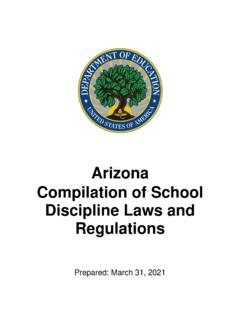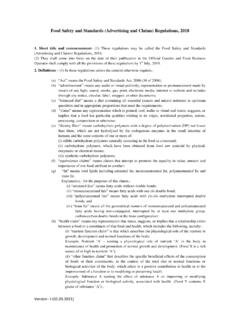Transcription of Health Protection Agency - WHO
1 Health Protection Agency compendium of Chemical Hazards: Kerosene (Fuel Oil). Prepared by: Robert P Chilcott Chemical Hazards and Poisons Division (HQ), Chilton, Didcot, Oxfordshire, OX11 0RQ, United Kingdom. Disclaimer This guidance has been provided by the Chemical Hazards and Poisons Division of the UK Health Protection Agency (HPA). It is general guidance based on current knowledge and understanding. The HPA does not warrant that the information and guidance is complete and correct for use in all circumstances. The HPA shall not be liable for any damages that might be incurred as a result of the use of the guidance or information. HPA compendium of Chemical Hazards Kerosene Key Points Fire Flammable Vapour/air mixtures are explosive Use normal foam and normal fire kit with breathing apparatus Health Toxicity occurs if kerosene is inhaled while being ingested (aspiration)
2 Irritating to eyes and skin Aspiration may cause respiratory irritation Acute and chronic exposure to kerosene may result in CNS effects including irritability, restlessness, ataxia, drowsiness, convulsions, coma and death The most common Health effect associated with chronic kerosene exposure is dermatitis Kerosene does not have a measurable effect on human reproduction or development IARC concluded that there was inadequate evidence to classify kerosene as s human carcinogen Environment Avoid release into the environment Inform Environment Agency of substantial incidents Prepared by R P Chilcott CHAPD HQ, HPA 2006 Version 1 KEROSENE CONTENTS Contents GENERAL INFORMATION Background Production and Uses Frequently Asked Questions INCIDENT MANAGEMENT Hazard Identification Standard (UK) Dangerous Goods Emergency Action Codes Chemical Hazard Information and Packaging for Supply Classification Physicochemical Properties Threshold Toxicity Values Published Emergency Response Guidelines Emergency Response Planning Guideline (ERPG) Values Acute Exposure Guideline Levels (AEGLs)
3 Exposure Standards, Guidelines or Regulations Occupational standards Public Health guidelines Health Effects Major route of exposure Immediate Signs or Symptoms of Acute Exposure Decontamination and First Aid Dermal exposure Ocular exposure Inhalation Ingestion TOXICOLOGICAL OVERVIEW Toxicological Overview Summary of Health Effects Kinetics and metabolism Sources and route of human exposure Health Effects of Acute / Single Exposure Human Data General toxicity Inhalation Ingestion Dermal / ocular exposure Neurotoxicity Delayed effects following an acute exposure Animal and In-Vitro Data General toxicity Delayed effects following an acute exposure Health Effects of Chronic / Repeated Exposure Human Data General toxicity Inhalation Ingestion Dermal / ocular exposure Neurotoxicity Genotoxicity Carcinogenicity Reproductive and developmental toxicity Animal and In-Vitro Data General toxicity Inhalation Ingestion Dermal / ocular exposure Genotoxicity Carcinogenicity Reproductive and developmental
4 Toxicity References Annex I: Classification of Fuel Oils. Annex II: Composition of C2 Fuel Oil (Example). Kerosene General information Key Points Fire Flammable Vapour/air mixtures are explosive Use normal foam and normal fire kit with breathing apparatus Health Toxicity occurs if kerosene is inhaled while being ingested (aspiration) Irritating to eyes and skin Aspiration may cause respiratory irritation Acute and chronic exposure to kerosene may result in CNS effects including irritability, restlessness, ataxia, drowsiness, convulsions, coma and death The most common Health effect associated with chronic kerosene exposure is dermatitis Kerosene does not have a measurable effect on human reproduction or development IARC concluded that there was inadequate evidence to classify kerosene as s human carcinogen Environment Avoid release into the environment Inform Environment Agency of substantial incidents Prepared by R P Chilcott CHAPD HQ, HPA 2006 Version 1 KEROSENE GENERAL INFORMATION Background Kerosene is a liquid mixture of chemicals produced from the distillation of crude oil.
5 In the UK, kerosene is also known as paraffin and home heating oil. The word kerosene comes from the Greek word keros , meaning wax . Kerosene is a major component (> 60%) of aviation (jet) fuels, is used for oil central heating systems and can be used as a cleaning agent or solvent. Approximately 7 millions tons of kerosene was used in the UK in 2005. Kerosene is produced on an industrial scale by distilling crude oil in a process similar to that used to produce diesel or petrol. The use of paraffin heaters in UK homes has substantially decreased since the second World War due to improved electrical and gas supplies. However, kerosene is still extensively used for cooking, heating and lighting in the developing world and so cases of accidental poisoning by children are still relatively common in such countries. Kerosene is not particularly poisonous. However, if a child or adult accidentally swallows kerosene, medical advice should be obtained immediately as there is a small risk of short-term lung damage if vomiting occurs.
6 Frequent skin exposure may lead to skin damage (dermatitis). Kerosene has traditionally been the fuel of choice for fire-breathers! KEROSENE GENERAL INFORMATION Production and Uses Key Points Production and uses Kerosene is a major component of aviation fuel It is also used as a solvent, degreaser and domestic fuel Kerosene is a major component (> 60%) of aviation (jet) fuels and has been used to control mosquito larvae. Kerosene is also used as a solvent (for example in cleaners, pesticides and paints), degreaser and domestic fuel. A deodorised form of kerosene (Deobase ) is sometimes used in domestic products. Approximately 45 million tons of kerosene was transported within the EU in 2001, of which 14 million tons were transported within the UK. KEROSENE GENERAL INFORMATION Frequently Asked Questions What is kerosene? Kerosene is a liquid fuel, similar in composition to diesel, obtained from the distillation of crude oil.
7 In the UK, kerosene is also known as paraffin . What is kerosene used for? The main use of kerosene is as a base for aviation fuel but it also has application as a solvent in paints, cleaners, pesticides and some eye medicines. It was previously a common fuel for stoves, heaters and lamps and is still used today as a fuel for home ( oil ) central heating systems. How does kerosene get into the environment? Kerosene is found in the environment as a result of accidental release from an industrial site or transport vehicle. There are no natural sources of kerosene. If there is kerosene in the environment will I have any adverse Health effects? Like most chemicals, the amount of kerosene you are exposed to must be above a certain level to cause adverse Health effects. Breathing large quantities of kerosene vapour or drinking kerosene-based liquids may cause non-specific signs such as dizziness, headache and vomiting.
8 Repeated skin exposure may result in dermatitis (eczema). A short, one-off exposure to kerosene is unlikely to result in any long-term effects. However, a severe form of lung injury called pneumonitis (pronounced new-mown-eye-tus ) may occur if liquid kerosene is inhaled directly into the lungs, for example, whilst manually siphoning a tank or from inhaling vomit after swallowing kerosene. This is why it is important not to make someone sick if they have swallowed a kerosene product. Can kerosene cause cancer? Kerosene is not considered to be a cancer-causing substance (carcinogen) but repeated exposure of animals to kerosene has caused skin cancer. Does kerosene affect or damage the unborn child? Exposure to kerosene is not thought to affect the Health of the unborn child. Kerosene Incident management Key Points Fire Flammable Vapour/air mixtures are explosive Low flashpoint Use normal foam and normal fire kit with breathing apparatus Health Toxicity occurs if kerosene is inhaled while being ingested Harmful Irritating to eyes and skin Aspiration may cause serious lung injury Environment Avoid release into the environment Inform Environment Agency of substantial release incidents Prepared by R P Chilcott CHAPD HQ, HPA 2006 Version 1 KEROSENE INCIDENT MANAGEMENT Hazard Identification( )a Standard (UK) Dangerous Goods Emergency Action Codes UN 1223 Kerosene EAC 3Y Use normal foam.
9 Wear normal fire kit in combination with breathing apparatus*. Spillages and decontamination run-off should be prevented from entering drains and watercourses. Substance can be violently or explosively reactive. APP - Class 3 Flammable liquid Hazards Sub risks - HIN 30 Flammable liquid (flash point between 23 C and 61 C inclusive). UN United Nations number; EAC Emergency Action Code; APP Additional Personal Protection ; HIN - Hazard Identification Number * Normal fire fighting clothing fire kit (BS EN 469), gloves (BS EN 659) and boots (HO specification A29 and A30) in combination with self-contained open circuit positive pressure compressed air breathing apparatus (BS EN 137). a Dangerous goods emergency action code list, HM Fire Service Inspectorate, Publications Section, The Stationery Office, 2004.
10 KEROSENE INCIDENT MANAGEMENT Chemical Hazard Information and Packaging for Supply Classification( )a Classification Xn Harmful Risk phrases R65 Harmful: may cause lung damage if swallowed S(2) Keep out of the reach of children S23 Do not breathe gas/fumes/vapour/spray S24 Avoid contact with skin Safety phrases S62 If swallowed, do not induce vomiting: seek medical advice immediately and show this container or label a Approved supply list (seventh edition): information approved for the classification and labelling of substances and preparations dangerous for supply. Chemical (Hazard Information and Packaging for Supply) Regulations 2002. The Stationery Office, 2002. Physicochemical Properties( , )ab Volatility Low volatility; vapour pressure = mm Hg at 20 C Specific gravity at 16 C (water = 1) Flammability Flammable Lower explosive limit Upper explosive limit 5% Water solubility Practically insoluble in water Reactivity Low flashpoint.



















